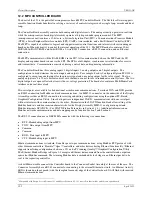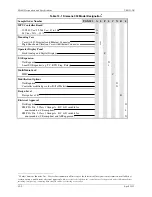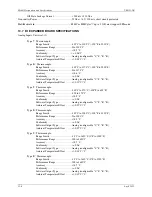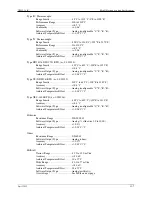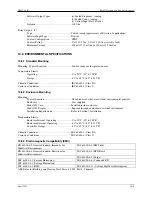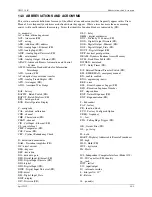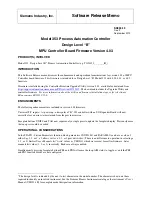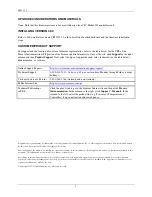
UM353-1B
Model Designation and Specifications
April 2012
13-11
13.9.2 Special Conditions for Safe Use
Always refer to the labels on the controller case for approvals and certifications applicable to that instrument.
FM
Enclosure Requirements:
•
The apparatus must be mounted within an enclosure or assembly to prevent personal injury resulting from
accessibility to live parts. The enclosure is typically user-supplied and, therefore, was not examined as part of
this Approval but shall comply with the requirements of this section.
•
Accessibility - The system must be installed within the enclosure so that its circuits are accessible by the use of
a tool only. A part is accessible when either a.) the IEC articulate accessibility probe applied in every possible
position to the exterior or exposed surfaces, including the bottom; or b.) the IEC rigid accessibility probe
applied with a maximum force of 30 Newtons (6.75 lbs force) in every possible position to the exterior or
exposed surface, including the bottom, touches the part.
•
Protection from Fire - If the enclosure is non-metallic, it shall have the proper flammability rating.
•
Grounding - A metallic enclosure must have a protective grounding terminal and be marked as such. All
accessible non-current conductive parts must be bonded to the protective grounding terminal.
•
General Construction - The equipment enclosure, or parts of the enclosure, required to be in place to comply
with the requirements for protection from electric shock, personal injury, protection of internal parts and wiring
and external cord and cable assembly strain relief shall comply with the following tests for mechanical strength:
•
Impact Tests - The equipment shall be held firmly against a rigid support and shall be subjected to sets of
three blows with 6.6 Joules (4.9 pound force-inch) from a spring-operated impact hammer. The hammer
shall be applied to any external part that when broken is likely to expose live parts. A window of an
indicating device shall withstand an impact of 0.085 Newton-meter (0.753 pound force-inch) from a
hollow steel impact sphere 50.8 mm (2 inches) in diameter and an approximate mass of 113.4 grams (4
ounces).
•
Pressure Tests - A force of 90 Newtons (20 pounds) shall be applied from a metal rod 12.7 mm (0.50 inch)
in diameter, the end of which is rounded. The force shall be applied for one minute to any point on the
overall enclosure except the bottom. The bottom shall sustain a force of 65 Newtons (15 pounds).
•
Tip Stability Test - Equipment having a weight of 11 kilograms (24 pounds) or more shall not tip over
when placed at the center of an inclined plane that makes an angle of 10 degrees with the horizontal and
then turned to the position (with all doors, drawers, and other openable and sliding parts in the least stable
position) most likely to cause tip-over.
•
Sharp Edges - An accessible edge, projection, or corner of an enclosure, opening, frame, guard, handle, or
the like shall be smooth and well rounded, and shall not cause a cut-type injury during normal use of the
equipment.
CE
•
Use of the equipment in a manner not specified by the manufacturer may impair the protection or
performance provided by the equipment.
•
Route the power to the controller through a clearly labeled circuit breaker or on-off switch that is located
near the controller and is accessible by the operator. The breaker or switch should be located in a non-
explosive atmosphere unless suitable for use in an explosive atmosphere.
•
Following is a Declaration of Conformance with the standards or other normative documents stated on the
certificate.
•
For critical applications using thermocouples and RTDs where improved performance is necessary at the
frequencies of use, other Siemens solutions are available. The Siemens Sitrans T series of Temperature
Transmitters with 4-20 ma outputs can be used as the input signal to the Model 353.
•
When using the contact closure as the frequency input to the Universal Digital Input, the debounce feature
for low frequencies may not function in an area of high Electrical Fast Transients. The use of flow meters
that provide solid state switches or contacts that do not bounce are recommended for these applications.
Summary of Contents for 353
Page 12: ...Contents UM353 1B x April 2012 ...
Page 22: ...Introduction UM353 1B April 2012 1 10 ...
Page 30: ...Configuration Overview UM353 1B April 2012 2 8 ...
Page 122: ...Function Blocks UM353 1B April 2012 3 92 ...
Page 168: ...Data Mapping UM353 1B April 2012 6 28 ...
Page 204: ...Controller and System Test UM353 1B April 2012 9 8 ...
Page 222: ...Calibration UM353 1B April 2012 11 4 ...
Page 226: ...Circuit Description UM353 1B April 2012 12 4 ...
Page 238: ...Model Designation and Specifications UM353 1B April 2012 13 12 EC Declaration of Conformity ...
Page 240: ...Model Designation and Specifications UM353 1B April 2012 13 14 ...
Page 244: ...Abbreviations And Acronyms UM353 1B 14 4 April 2012 ...


